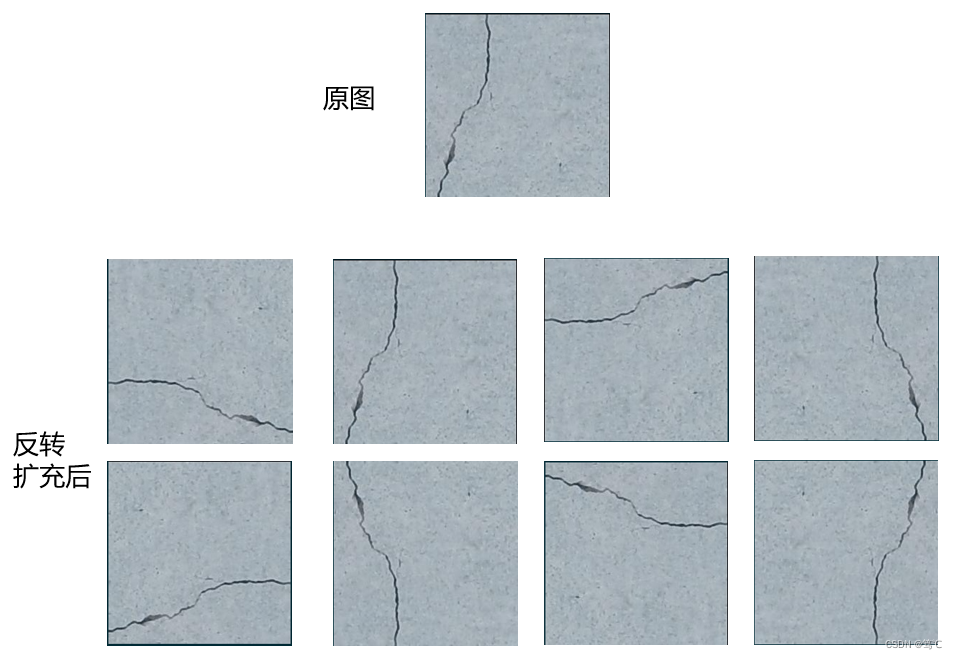【图像数据扩充】翻转、亮度、对比度、锐度、色彩等扩充
创始人
2025-05-30 15:32:05
0次
【图像数据扩充】翻转、亮度、对比度、锐度、色彩等扩充
文章目录
- 【图像数据扩充】翻转、亮度、对比度、锐度、色彩等扩充
- 1. 介绍
- 2. 代码及示例
- 2.1 基于 Opencv 的翻转
- 2.1.1 效果
- 2.2 基于PIL的亮度、对比度、锐度、色彩变化
- 2.2.1 效果
- 3. 总结
1. 介绍
当我们使用深度学习进行训练时,数据集如果不充足,会想到去扩充数据。下面我们就介绍五种常用的扩充方法。
- 翻转变化:对图像进行旋转和水平、垂直反转等操作。
- 亮度变化:对图像的亮度进行改变。
- 对比度变化:也就是对图像的明暗区域之间的色觉差距进行调整。
- 锐度变化:对图像的边缘或者线条进行增强,也即突出边缘感。
- 色彩变化:对色彩进行调整,黄色变绿色等。
2. 代码及示例
2.1 基于 Opencv 的翻转
import cv2'''1. 旋转'''
def cv2_rotation(img, angle): '''输入图像、要旋转的角度'''(h, w) = img.shape[:2]center = (w // 2, h // 2)M = cv2.getRotationMatrix2D(center, angle, 1.)rotated = cv2.warpAffine(img, M, (w, h))return rotated'''2. 反转'''
img1 = cv2.flip(img, 0) # 水平翻转
img2 = cv2.flip(img, 1) # 垂直反转
img3 = cv2.flip(img, -1) # 水平垂直反转
2.1.1 效果
对上述的旋转和反转做不同的组合,可以得到,

2.2 基于PIL的亮度、对比度、锐度、色彩变化
from PIL import Image, ImageEnhance
import cv2
import numpy as npdef randomColor(image): # 图像增强# 亮度变化enh_bri = ImageEnhance.Brightness(image)brightness = np.random.randint(8, 13) / 10. # 随机因子image1 = enh_bri.enhance(brightness)# 色度变化enh_col = ImageEnhance.Color(image1)color = np.random.randint(5, 25) / 10. # 随机因子image2 = enh_col.enhance(color)# 对比度变化enh_con = ImageEnhance.Contrast(image2)contrast = np.random.randint(8, 25) / 10. # 随机因子image3 = enh_con.enhance(contrast)# 锐度变化enh_sha = ImageEnhance.Sharpness(image3)sharpness = np.random.randint(5, 51) / 10. # 随机因子image4 = enh_sha.enhance(sharpness)return image4
2.2.1 效果

3. 总结
针对一个图像,我们可以
- 通过翻转扩充:1张变8张
- 之后再进行亮度、对比度、锐度、色彩的变化,进而一张可以变成百张,
这样就可以实现图像数据的扩充。当然这里还没有包括一些裁剪,mask的操作,因为我的任务不同。
相关内容
热门资讯
最新或2023(历届)山西高职...
3月20日前 招生院校制定《自主招生章程》并向社会公布 3月31日至4月1日 考生登陆山西招生考试网...
最新或2023(历届)北京高考...
最新或2023(历届)高考外语口试将于4月11日、12日进行,全市共设六个考点。4月23日起,考...
吉林将10所省重点高校2%招生...
最新或2023(历届)吉林省教育工作会昨日在吉林省宾馆召开。会议总结了最新或2023(历届)我省教育...
使用GPT-4生成QT代码
一、概述 最近ChatGPT火爆起来了,ChatGPT是一种基于GPT的自然语言处理模...
最新或2023(历届)湖南大学...
湖南大学坐落在中国历史文化名城长沙,校区位于湘江之滨、岳麓山下,享有“千年学府,百年名校”之誉。她不...
教育部要求直属高校设置独立内部...
教育部今日公布了《关于加强直属高等学校内部审计工作的意见》(以下简称《意见》),这是第一次专门对直...
报名CSGO/steam游戏搬...
报名CSGO/steam游戏搬砖项目前,这些内幕一定要了解 我相信大多数人都经常困惑...
最新或2023(历届)海南高考...
最新或2023(历届)海南高考一本录取结果查询通知书发放时间,理科录取7214人文科录取1926人海...
最新或2023(历届)上海高考...
最新或2023(历届)上海高考二本线上投档文科院校投档分数线和录取结果查询最新或2023(历届)上海...
css问题
display:none;与visibility:hidden; 与 opacity:0的区别 联系...
最新或2023(历届)延边大学...
最新或2023(历届)延边大学录取通知书发放时间及开学时间和新生入学指南军训须知延边大学(Yanbi...
最新或2023(历届)广东高考...
最新或2023(历届)广东高考二A院校补录征集志愿安排资格线和录取结果查询时间我省二A院校开始征集志...
最新或2023(历届)吉林大学...
最新或2023(历届)吉林大学录取通知书发放时间及开学时间和新生入学指南军训须知 吉林大学于2000...
深度文本分类之DPCNN
文章目录深度文本分类之DPCNNDPCNN结构Region Embedding等长卷积固定Featu...
串行通信协议(I2C、SPI、...
推荐一部书,在这本书里面详细介绍了I2C、SPI、UART和CAN等通信协议ÿ...
最新或2023(历届)上海高考...
一、平行志愿的投档规则1.各招生院校根据生源情况,一般按本校在本批次公布招生计划数的100%至105...
最新或2023(历届)山西高考...
最新或2023(历届)山西高考第一批本科A类院校征集计划第一批本科A类院校征集计划院校院校名称专业专...
最新或2023(历届)海南高考...
最新或2023(历届)海南高考二本录取分数线公布,本科第二批正式投档高招本科第二批正式投档 本报海...
最新或2023(历届)吉林高考...
最新或2023(历届)吉林省普通高校招生录取地方重点高校招收农村学生专项计划批(地方专项计划)第二轮...
最新或2023(历届)山西高考...
最新或2023(历届)山西高考一本征集志愿补录分数线,B类院校征集计划最新或2023(历届)山西高考...
